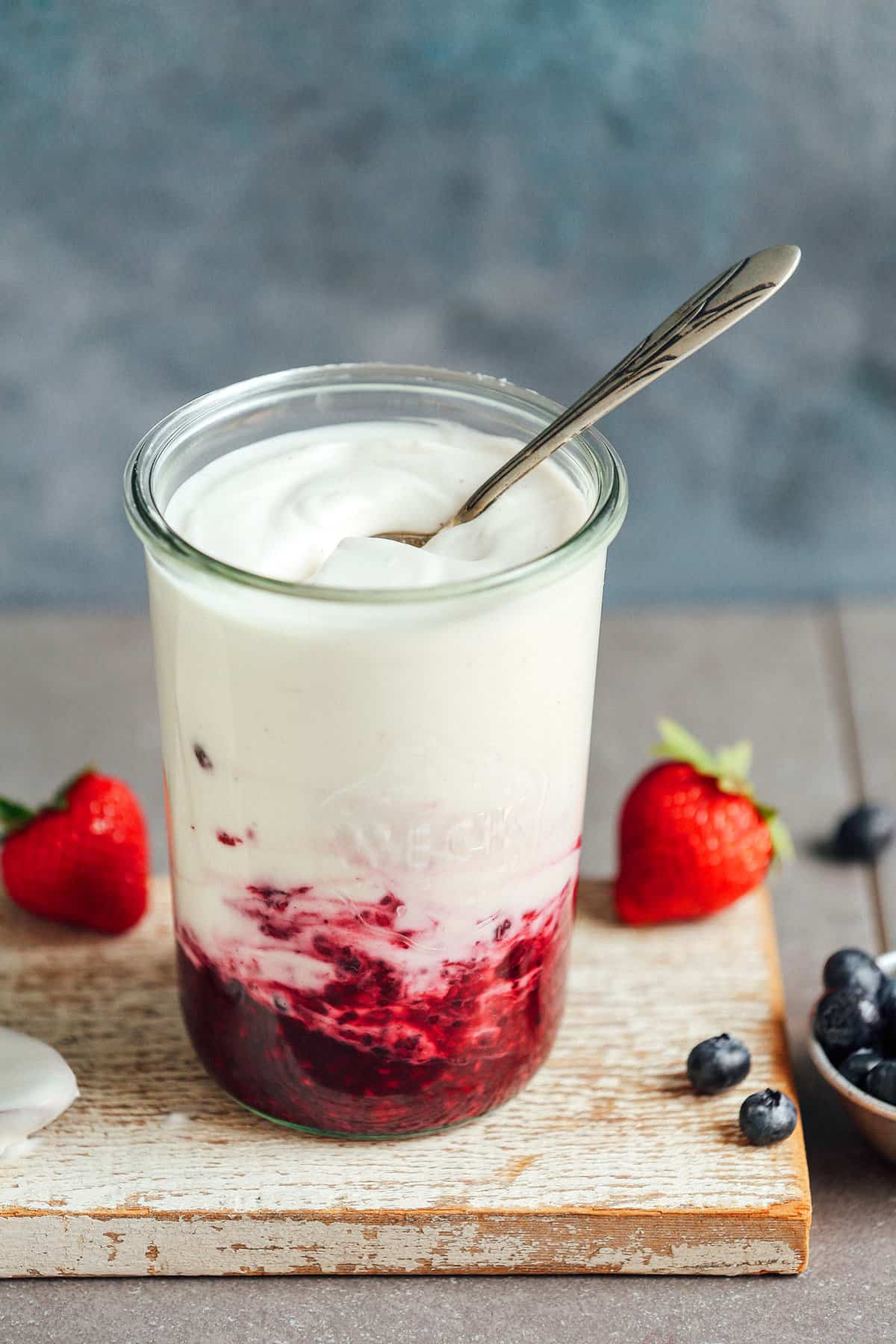Unleash the Creaminess: Easy Homemade Coconut Yogurt without Probiotics
Hey there, health-conscious parents and yogurt aficionados! ?? Are you ready to dive into the world of homemade, dairy-free deliciousness? Today, I’m over the moon to share a super simple, probiotic-free coconut yogurt recipe that’s perfect for those who love going the extra mile for their family’s health and taste buds. Whether you’re vegan, lactose-intolerant, or just looking to spice up your breakfast routine, this guide is your ticket to a creamy, tangy paradise.
A Bit About Coconut Yogurt ?
First off, let’s talk about what makes coconut yogurt the superstar of plant-based yogurts. It’s rich, it’s creamy, and it’s packed with all the goodness of coconuts – think fibers, vitamins, and healthy fats. Plus, it’s a fantastic canvas for your favorite toppings and mix-ins. From here on out, coconut yogurt will be your fridge’s MVP – mark my words!
Gathering Your Ingredients ?
Before we roll up our sleeves, let’s make a shopping list. For this mesmerizing kitchen endeavor, you’ll need:
- 4 cups of good-quality, full-fat coconut milk (Cans work best! Make sure it’s unsweetened and free from additives)
- 2 tablespoons of lemon juice or apple cider vinegar (For that yogurt-like tang)
- 1 tablespoon of tapioca starch or agar agar (This is what gives us the dreamy thickness)
- A pinch of sea salt (To enhance all the flavors)
- Your sweetener of choice (optional, but a little maple syrup or honey brings a lovely hint of sweetness)
That’s it! No hidden nasties, no need for store-bought probiotics – just pure, simple, and wholesome ingredients.
The Magic Begins: Making Your Coconut Yogurt ?
Alright, it’s time to create some magic in our very own kitchens! Here’s how you make the creamiest, dreamiest coconut yogurt without any probiotics:
- Start by pouring the coconut milk into a saucepan. Heat it gently on a low to medium flame. You want it warm, not boiling – think cozy bath temperature.
- While the milk is warming up, sprinkle in your thickener – tapioca starch or agar agar. Whisk it thoroughly to make sure there are no lumps. Lovely!
- Alright, now add that pinch of sea salt, and if you’ve decided on that sweetener, get it in there as well.
- Next, remove the coconut milk from the heat right before it starts to simmer. Stir in the lemon juice or apple cider vinegar – this is what introduces the tang and the twang!
- Now, pour this coconut concoction into a clean glass jar. A good tip is to sterilize your jar beforehand – a quick dance in some boiling water does the trick. Safety and cleanliness first!
- Let your mixture cool to room temperature. Patience is key here, as we don’t want to shock our future yogurt with drastic temperature changes.
- Once cooled, cover the jar with a cheesecloth or a clean kitchen towel and let it sit in a warm, undisturbed corner of your kitchen. A soothing 24 to 48 hours should do it.
- Check on the mixture after a day; what you’re looking for is a gentle tanginess and a firmed-up consistency. If it’s not quite there yet, give it a little more time.
- Once you’ve obtained the perfect tang and texture, give it one last gentle stir, and pop it into the refrigerator. Chilling will help the yogurt set further and develop its flavors.
Voilà! In just a couple of days, you’ll be scooping up heavenly, homemade, probiotic-free coconut yogurt. Remember to save a little bit from each batch – it can be the starter for your next yogurt-making adventure!
But wait, there’s more!after letting your yogurt set in the fridge for a few hours – ideally overnight – you’re all set for the grand finale: tasting your creation! Scoop yourself a generous portion, add a swirl of honey or a sprinkle of your favorite nuts and fruits, and enjoy your very own homemade coconut yogurt without probiotics. Trust me, your taste buds will thank you – and so will your gut!
Stay tuned, because as delicious as this yogurt is on its own, I’ve got some stellar serving suggestions and fun flavor twists lined up that will make your yogurt game stronger than ever. So, grab a spoon, tuck in, and let every bite take you closer to coconut bliss! ??
The wonders of making coconut yogurt without probiotics don’t stop here. It’s not just about enjoying a yummy snack; it’s about embarking on a delightful culinary journey that opens doors to infinite creativity and nourishment. And isn’t that what cooking for our loved ones is all about? Join me as we continue to explore the joys of homemade coconut yogurt – your kitchen will never be the same!

5 Things Parents Should Know When Preparing Coconut Yogurt Without Probiotics
As you embark on this delicious and nutritious journey, here are five handy tips to ensure your homemade coconut yogurt triumph:
1. Temperature is Key ?
Keeping a close eye on the temperature of your coconut milk is crucial. Warm it enough to activate the thickening agent, but not so much that it starts to boil. Overheating can destroy the subtle flavors and alter the final texture. Cozy warmth is what we’re aiming for – just like a warm hug for your yogurt!
2. Choosing The Right Coconut Milk ?
The coconut milk you choose will significantly influence your yogurt’s taste and consistency. Opt for full-fat, unsweetened varieties that don’t contain additives or emulsifiers. These can mess with your yogurt’s ability to set and develop flavor, so read those labels with your detective glasses on!
3. The Waiting Game ?
A little patience can transform your yogurt from good to extraordinary. The fermentation process takes time, and rushing it won’t do any favors. Set the stage for your yogurt to develop that lovely tang and thickness by letting it rest in a warm spot for at least 24 hours. It’s worth the wait, pinky promise!
4. Cleanliness is Next to Yumminess ?
Working with a squeaky-clean setup is non-negotiable. Sterilize jars and utensils beforehand to ward off unwanted bacteria. You’re aiming to culture specific flavors and textures, not to host a bacteria party. A minute with boiling water or a rinse in the dishwasher should set you up for success.
5. Personalize Your Pot ?
Let your family’s taste guide you in customizing your coconut yogurt. Whether it’s a drizzle of maple syrup, a handful of berries, or a sprinkle of cinnamon, there’s endless freedom to create a version of coconut yogurt that tickles everyone’s fancy. It’s like painting – but with flavors!
Now that the essentials are crystal clear, you’re all set to begin this fun and flavorful adventure. Your homemade coconut yogurt journey is not just about the satisfaction of making something from scratch or the health benefits it brings – it’s also about the joy of involving the whole family in the process. Picture it: your children’s faces beaming with pride as they dig into the creamy creation they helped bring to life. That’s what homemade really means – love in every scoop!
And remember, this guide is just the beginning. As you master the art of coconut yogurt creation, feel free to get creative. You’re not just a chef – you’re a yogurt whisperer, a dairy-free maestro, a culinary magician waving a wand of coconut goodness. The kitchen is your stage, and this guide, your trusty script. So, let your imagination run wild with all the possibilities that await in your very own coconut yogurt encore.
Embrace the excitement, the little learning curves, and, of course, the delicious rewards. Each spoonful of homemade coconut yogurt you and your family enjoy is a testament to your dedication to healthier, happier eating. So, here’s to many tasty batches of coconut yogurt ahead – may they be as fun to make as they are to eat!???????
See more great Things to Do with Kids in New Zealand here. For more information see here
Disclaimer
The articles available via our website provide general information only and we strongly urge readers to exercise caution and conduct their own thorough research and fact-checking. The information presented should not be taken as absolute truth, and, to the maximum extent permitted by law, we will not be held liable for any inaccuracies or errors in the content. It is essential for individuals to independently verify and validate the information before making any decisions or taking any actions based on the articles.




